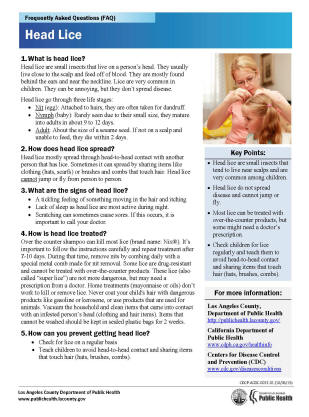Head Lice
Head
lice are small insects found on the heads of people. They are parasitic, since they feed on human blood. Without blood, they cannot survive. Lice that fall off a person's head cannot survive in the environment for no more than two days. Lice do not jump and do not have wings to fly. They are most often spread by head-to-head contact with an infested person.
Contact can occur by sharing infested clothing (hats,
scarves, coats, etc.) or by using infested items (combs,
brushes, towels, etc.). Infestations are treated with
medicated shampoo. Head lice is common among school-aged
children. Routine or school-wide screening does not
reduce infestation rates. Instead, the
California Department of Public Health recommends
routine screening by parents or caregivers. Parents and students
should be educated about head lice as it can cause
embarrassment and misunderstanding. Head lice can occur
among all socioeconomic groups and is not tied to poor
personal hygiene or uncleanliness. Also, head lice do
not carry disease.
Resources
|
A toolkit with resources to support infection prevention in school settings.
|
|
For school districts and child care facilities. Revised March 2018.
|
|
CDCís official page with detailed information on head lice.
|
Health Education Materials

|
State-provided flyer with general information on head lice prevention and control.
|

|
Visual guide showing the stages of the head lice life cycle.
|


